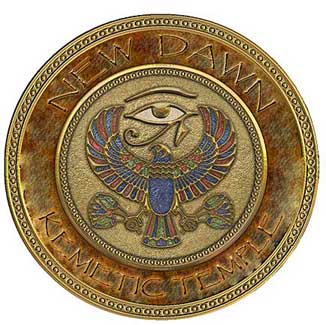|
|
|


~John Warren~
It is fairly clear that prior to Egypt’s unification around 3,000 BC, it was probably controlled in the North by one group of people and in the south by another. There were two lands, Upper (because it was up river), or Southern Egypt and Lower, or Northern Egypt. We believe that at this time the most important city in Lower Egypt was Nekhen (Greek Hierakonpolis, meaning "city of the falcon"). Even after Egypt’s unification during the early dynasties, it remained an important city, and at times, might have been considered Egypt’s capital. The Greek name for this city would indicate that the chief deity worshipped was probably the Falcon God, Horus.
In the North, Nekhen’s counterpart was Buto, which we believe is the area known as Tell el-Farain today (though there is some uncertainty regarding this). It is located about ninety-five kilometers east of Alexandria near a small village that still preserves the ancient name after 5,000 years. During ancient times, it was in Nome VI (Mountain Bull). Just as Nekhen, Buto continued to be an important center into the early dynasties of a united Egypt. We believe that Buto is probably shown on the Narmer Palette as a major Delta center. Wilkinson tells us that Qa'a's Tomb seal impression names a Royal Palace located at Buto as Hwt Pe Hor Mesen (or Hwt Pe Hor Way), which was built during the 1st Dynasty and was still active during the third dynasty.
Buto probably came about as the merger of two different centers. The Pyramid Text refers to the "kings of Lower Egypt who were in Pe. In some of the references, Pe is associated with Horus, the Falcon god, so early on Horus was probably worshipped in both Lower and Upper Egypt. The text also references a place called Dep where the god Wadjet was worshipped. Pe and Dep were apparently neighboring cities. Eventually, these two cities together were called Per-Wadjet reflecting their two gods and from this came the Greek name of Buto. Hence, the Wadjet cobra goddess is often referred to as Buto. Egypt Mythology also tells us that in the famous story of Isis, Osiris, Horus and Seth that After Osiris was killed by Seth, Isis hid Horus near the sacred town of Buto with the help of the goddess Hathor.
The remains of Buto consist of three mounds, comprising two cities and a temple complex. The area was occupied into the Roman period, and was first identified as ancient Buto by Flinders Petrie in 1888. In 1904, C. T. Currelly undertook trail excavations, but the site was left mostly unexplored until the excavations and survey by Veronica Seton-Williams and Dorothy Charlesworth in the 1960s. These initial excavations revealed Late Period, Ptolemaic and Roman remains, including cemeteries, houses, baths and temples.
Predynastic remains were not discovered until the excavations of Thomas von der Way in the 1980s. Part of Way's discoveries included clay 'nails' and what has been called Grubenkopfnagel, which is a tapering cone with a concave burnished end that resembles artifacts used in the Mesopotamian Uruk culture to decorate temple facades. He also discovered pot shards decorated with whitish stripes characteristic of the Syrian 'Amuq F ware. Because of this evidence, Thomas von der Way suggested that even during this early period, the Delta Egyptians had contact with the Uruk culture, perhaps through northern Syria.
Other archaeology finds shows that Buto was probably occupied for 500 years during the Predynastic Period. Evidence from Buto suggests that this northern land was first influenced by the style of pottery found in the south, and that later the region was enveloped by southern culture. Such finding suggest that development in the North lagged behind that of Southern Egypt and supports the theory that eventually it was Southern kings who unified Egypt.
Interestingly, while considerable ruins dating to predyanstic Egypt and Egypt's late period exist at Buto, there is little to suggest that Buto was any more then a small village during most of the Old and Middle Kingdom periods. Yet tomb paintings in Middle Egypt and the south suggest that Buto remained a capital of the North. Some archaeologists believe that the Egyptians used Buto more as a symbolic capital for balance with the South. However, it was surely a religious center, and Herodotus tells us that it was famous during Egypt's Persian period for its oracles.
Excavations continue at Buto, and we find one of the latest dig reports dating from Spring, 2000 from the Netherlands Foundation for Archaeological Research in Egypt stating that:
"The DAI team directed by Ulrich Hartung excavated an area adjoining previous work, north of Sekhmawy, exposing parts of the cell-like mud-brick foundations of four large Saite buildings and domestic structures of an earlier Saite occupation. Cut into the brickwork were remains of (early) Roman burials. Some of the cells contained round silos, others were reused as tombs already in late Saite or Persian times. In building 2, a grave in one of the cells contained burnt remains of 2 or 3 wooden coffins, over 500 shabtis and many faience plaques and amulets. The revealed LP structures can now be compared with the results of last season's geophysical survey done by Tomasz Herbich in the same area. Immediately below the Saite remains, smaller walls and a deposit of beer-jars of ED date were exposed, belonging to a large, probably administrative building of the 1st/2nd Dyns, of which other parts have previously been revealed. "
Today there is really not much to see at Buto. As elsewhere in the Delta, monumental sites have been largely ruined by water, and in fact powerful pumps must be utilized for digs in the area because the predynastic levels are below the current water table.